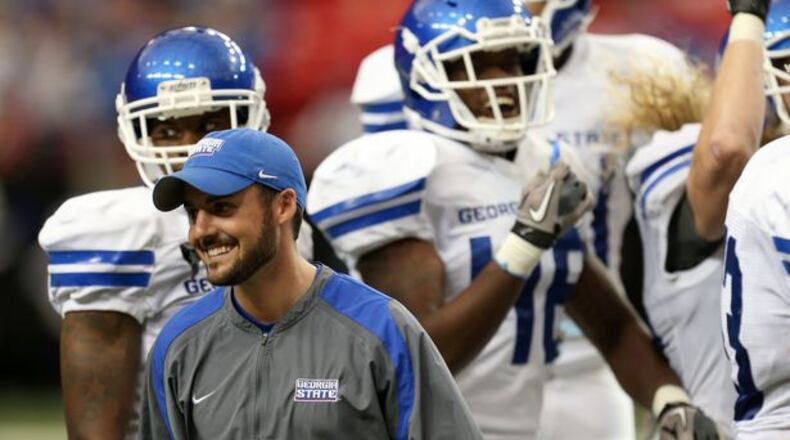In the South, football — particularly college football — is more American than apple pie. The pageantry of the game and the surrounding events, from pre-game tailgating to the celebratory fight song, have become an almost required college experience.
But games and teams and coaches and stadiums come with a price, and at many colleges the cost is borne by students who will never play a single down.
A recent study by the Chronicle of Higher Education and the Huffington Post found that over the past five years public universities have poured more than $10.3 billion in mandatory student fees and other subsidies — including institutional and state contributions — into their sports programs.
The study examined 201 public universities competing at the highest level of the National Collegiate Athletic Association, Division I sports. In Georgia, the report included analysis of the University of Georgia, Georgia Tech, Georgia State, Georgia Southern, Kennesaw State and Savannah State.
Students at those six institutions have contributed almost $213 million in athletic fees to sports programs over the past five years, according to data the schools provided.
The size of student subsidies at Georgia schools and nationwide has spurred questions about whether students really understand what they are paying for, and whether they are getting a good return on their athletic-fee “investment.”
At Georgia State, which was highlighted in the Chronicle report, student fees accounted for more than $85 million in support to the schools' sports programs, one of the highest contributions in the country.
“Should we be spending $85.7 million dollars from student fees on athletics?,” Sebastian Parra, Georgia State’s student government president posted on Twitter.
The burden on students at schools like UGA and Georgia Tech, with storied sports programs and strong alumni support — and perhaps most importantly, winning teams — isn’t as high. Student at those schools contributed about $16 million and $24 million in sports fees, respectively for the same five-year period.
“Places like Kennesaw State and Georgia State don’t have that revenue as part of their model” so have to rely more on student fees, said J.C. Bradbury, a sports economist at Kennesaw State University. Comparing those schools with others who have added football programs recently, like the University of North Carolina at Charlotte and the University of Texas at San Antonio, is likely a better comparison. UNC-Charlotte students contributed about $61 million in fees for sports programs over the past five years.
In 2010, four of the six Georgia universities examined in the report — Georgia Tech and UGA were the exceptions — subsidized at least 68 percent of the costs incurred by their athletic departments. By 2014, the minimum subsidy among the four schools had dropped only one percentage point, to 67 percent.
“A lot of what is going on with this is a trend. Most universities are not-for-profit institutions and they survive by getting people to give money back,” Bradbury said. “At any big SEC schools it’s a parade of RVs to get to the stadium that’s full of alumni and they are giving back.”
Also driving the demand many times are the students themselves. Despite the costs, school administrators say students expect their universities to field competitive sports teams.
Georgia State senior Christopher Walker said many of his friends don’t attend his school’s football games because “they don’t think the team is going to win.” Walker doesn’t attend because he works at the time they take the field on Saturdays at the Georgia Dome.
For Walker, who graduates next semester, a school football team never played a role in his college selection. “I was more focused on school and which could get me the best education and prepare me best for the workforce after graduation,” he said.
“The information” on the cost of the fees “is surely out there. Whether students are fully cognizant of what that means …” Bradbury said, trailing off. “It’s hard to know in a not-for-profit business what is the optimal amount to charge; still the reason behind these (athletic fee) raises has been because it seems to be what students want.”
Ted Carter is the father of a Kennesaw State student who wanted to go to a school with a football team. Carter had been in Miami when Florida International University began its football program in the early 2000’s, “and I saw what happened with student fees there,” he said. So, when Kennesaw State decided to field a football team in 2010, “I knew what was coming,” Carter said.
Schools in Georgia's public university system are required to get approval from the state Board of Regents before they can create or add sports or change competition levels. The proposal must show support and approval from students and the community and assure athletic opportunities for both genders, among other things.
Five years before Kennesaw State began its inaugural football season this year, students approved a $100 increase in student fees to support football. They now pay an athletic fee each semester of $221.
Students at Savannah State pay the most in athletic fees of any of Georgia's 30 public colleges and universities, $300 each semester this school year. The school's football team has lost all but one of its games this fall. Since joining the NCAA's top level in 2013, Georgia State's football team has gone 4-29.
At schools like this, are students getting a return on their investment?
“The NCAA says well over half the football teams in Division 1 and most below that, lose money,” said Murray Sperber, a visiting professor in the Cultural Studies of Sport in Education program at University of California, Berkeley and the author of several books on college sports. “It breaks down to if a team has a chance of winning and attracting attention to the school, that seems to make undergraduates feel good.”
About the Author
Keep Reading
The Latest
Featured



